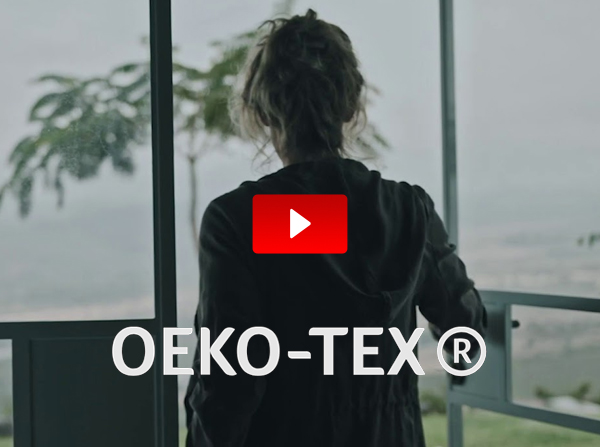
from the CEO's desk
Serge Rolle
Chief Executive Officer
“Sustainability isn’t a trend, it is an attitude!” TESTEX is committed to innovation, transparency and ethical responsibility – now and for the future. Actions speak louder than words - TESTEX therefore welcomes the developments of the industry towards a more sustainable and transparent future.
“The consumer mindset has shifted. People want to know whether a product they’re buying went through an environmentally and socially sound production process.”
Only if the whole supply chain addresses the challenges of the industry can we together create the big impact which the environment urgently needs. This is why TESTEX’s focus is to provide transparent and sustainable solutions for companies along the whole supply chain.
Policy
Sustainability Policy
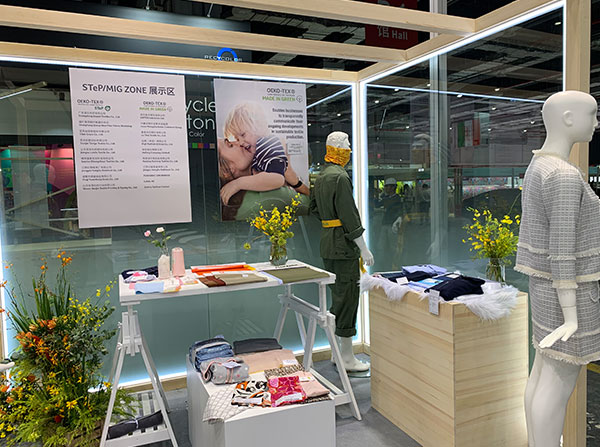
Founded in 1846 and originally known as the “Seidentrocknungsanstalt Zurich” (Silk Conditioning House), TESTEX is one of the oldest companies in Zurich. Its transformation into a leading independent testing institute for human ecology began in the early 1990s. The media had begun to report on harmful substances in clothing due to the chemicals used in textile production. At this point TESTEX had already been testing textiles externally for substances such as pesticides. A lack of existing legal regulations combined with an increasing demand from consumers for skin-friendly textiles led OETI (today a TESTEX subsidiary) to create the STANDARD 100 by OEKO-TEX® certification for textiles tested for harmful substances together with another testing institute, which was followed by the creation of the OEKO-TEX® Association in 1992.
The association and its founding institutes have spent more than two decades envisioning a sustainable textiles industry and pride themselves on being pioneers in sustainability solutions. Being one step ahead of market demand has played a significant role in achieving the trust and credibility that OEKO-TEX® enjoys today. While textiles free from harmful substances fulfilled consumer needs at the time, OEKO-TEX® was already aware that the industry needed to take further steps to include environmental protection and social responsibility. The answer to these needs were the predecessors of STeP and MADE IN GREEN by OEKO-TEX®, which although already available in the mid to late 1990s, only found resonance in the market much later.
The developments in the textiles industry towards a more sustainable future have also played a big role in the evolvement of textile testing methods in recent years. Better norms and added parameters have made textile testing techniques more precise. In 2018, TESTEX added GMO cotton testing to its portfolio and it is constantly involved in R&D projects, including sludge and wastewater method development, lifecycle assessment and certification of recycled textiles.
Today, TESTEX focuses on a holistic approach, offering its customers complete solutions in order to successfully take on the sustainability challenges that the fashion industry faces today. Striving for excellence in environmental performance requires a continuous exchange with stakeholders, industry initiatives and monitoring of legal regulations. TESTEX and OEKO-TEX® are ZDHC contributors, driving the global implementation of safer chemical management practices. OEKO-TEX’s products also prepare facilities for the requirements of Greenpeace’s Detox Campaign by ensuring MRSL conformity. Furthermore, OEKO-TEX® is a member of the Leather Working Group (LWG).
OEKO-TEX® is committed to the goals of the fashion industry’s climate action charter and its anchored principles and is ready to work with its customers and relevant stakeholders to further develop, implement and continuously improve the climate action agenda in our textile and fashion industry. For these reasons, OEKO-TEX® was delighted to sign the “Fashion Industry Charter for Climate Action”, which was launched at COP24 in December 2018 by the United Nations Framework Convention on Climate Change (UNFCCC).
About
Company Background
TESTEX is a globally operating and independent Swiss testing and certification company with a focus on textile testing. In addition to its headquarters in Zurich (Switzerland), the TESTEX Group now operates more than 25 branches with more than 280 employees worldwide (including its subsidiary OETI). TESTEX’s expertise lies in testing, analysing and certifying textiles and leather. Thanks to its high-quality services, independence, and innovative strength, this long-established company was first valued in Europe and later worldwide.
Sustainability, transparency and ethical standards are core principles to which TESTEX is committed. With its testing and certification services TESTEX supports manufacturers, suppliers, dealers, brands and end-users. It thus assumes responsibility towards society and the environment—now and in the future.
TESTEX has been a member of the OEKO-TEX® association since 1993. OEKO-TEX® enables consumers and companies to protect the planet by making responsible decisions. It offers companies of the textiles and leather industry several certifications and services to have their products tested for harmful substances by autonomous institutes, and to optimise their production conditions and their supply chains with regard to sustainability. OEKO-TEX® services offer independent certification, have international validity, and test criteria and limit values are either in conformance with or go far beyond applicable national and international regulations.
Global
Standards and Transparency
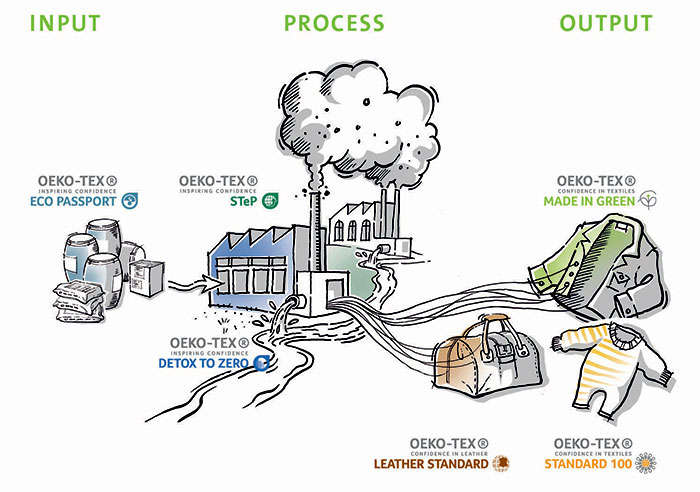
A truly sustainable textiles and leather industry requires a global standard for environmental and social responsibility that raises the bar wherever products are made. Today’s fast-paced retail market requires companies to have tremendous flexibility in order to respond to opportunities in a cost-effective and timely manner. Global standards remove the complexity involved with qualifying new resources quickly and with confidence and ensure that any country’s sustainability standards are met, and usually exceeded, no matter where the products are made.
Sustainability itself is inherently complex and covers many issues ranging from resource and land use to pollution and economic development to name just a few. Coming up with long-term, sustainable answers to textiles and leather sustainability requires significant planning, investment and ongoing improvement. Global standards can help simplify that planning process by defining the rules of engagement for all parties who choose to participate in a more sustainable industry.
“Transparency leads to accountability which leads to change.” (Fashion Revolution). Although companies are increasingly sharing their policies and commitments on social responsibility and the environment, there is still a lot of information about the practices of the fashion industry that remains hidden, particularly when it comes to the impact it has on the lives of workers in the supply chain and on the environment.
For companies to make sure that products are made in environment-friendly facilities and safe and socially responsible workplaces, they need to know exactly where and under what conditions their products are being made.
This is why transparency is essential and why brands need to share this information publicly so that consumers can hold the industry to account for working conditions and environmental impact.
Transparency alone is not the solution to the fashion industry’s problems, but it is a necessary first step so that we can better understand how to change the system for the long term in a fundamental and positive way.
TESTEX is confident that the MADE IN GREEN by OEKO-TEX® traceable product label already goes a long way towards achieving this goal.
- STANDARD 100 by OEKO-TEX® and the LEATHER STANDARD by OEKO-TEX® are independent certifications for textile and leather products respectively at all stages of production, which verify that the item has been tested for harmful substances. On the basis of a scientifically-based catalogue of criteria and neutral laboratory tests, companies in the supply chain are given targeted support in implementing the human-ecological product safety they are striving for. They are the only certifications of their kind on the market that test such a wide range of chemicals for harmful substances. They can also be combined for garments or accessories which contain both textile and leather components.
- STeP by OEKO-TEX® is a modular certification system whose goal is the permanent implementation of environment-friendly production processes, the improvement of health and safety and the promotion of socially responsible working conditions in companies along the entire textile and leather supply chain. The six modules cover chemical management, environmental performance, environmental management, social responsibility, occupational health and safety and quality management. By regularly updating the STeP criteria, certified companies can continuously improve their environmental performance and social responsibility.
- MADE IN GREEN by OEKO-TEX® is a traceable product label for textiles and leather products made with materials tested for harmful substances, made in environment-friendly facilities and made in safe and socially responsible workplaces. The product ID and the QR code on the label allow consumers to inform themselves about the responsible actions of brands and their suppliers. As buying decisions become more complicated and corporate transparency becomes more elusive, consumers are increasingly demanding credible proof of the product responsibility of textile and leather companies along the entire value chain. Products qualify for this label if they have been produced in STeP by OEKO-TEX® certified facilities and have been tested for harmful substances through the STANDARD 100 or LEATHER STANDARD by OEKO-TEX® certification process.
- ECO PASSPORT by OEKO-TEX® is a certification which supports companies in the selection of environment-friendly chemicals, colorants and auxiliaries that are safe in terms of human ecology. It offers a comprehensive platform to analyse compliance with MRSLs and RSLs. It can be easily integrated with STANDARD 100, the LEATHER STANDARD and STeP to simplify the certification processes. Eco Passport is recognised by the ZDHC Programme for MRSL conformance.
- DETOX TO ZERO by OEKO-TEX® is a verification and reporting system which enables manufacturers along the textiles chain to assess whether their chemical management, and wastewater and sludge are in line with the goals of the Greenpeace Detox campaign which aims to eliminate the release of toxic chemicals. It is now also an integrated component of STeP.
Project
Lifecycle Assessment Pilot Project
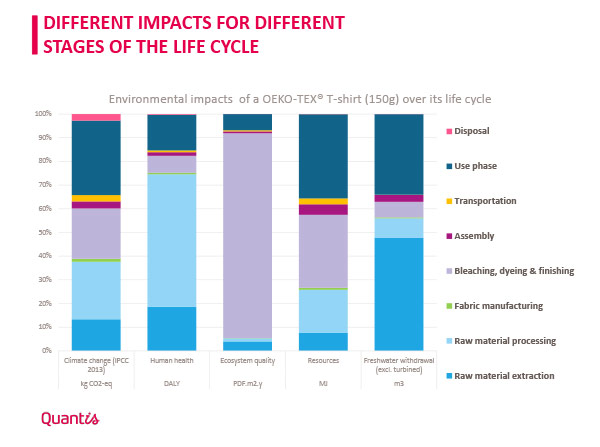
TESTEX has embarked on a pilot project to assess the lifecycle of an OEKO-TEX® certified t-shirt together with one if its customers and Quantis, a company specialised in guiding top organisations to define, shape and implement intelligent environmental sustainability solutions. The goal is to be able to calculate the t-shirt’s carbon footprint—that is, the amount of carbon dioxide or carbon dioxide-equivalent generated per facility and product from the data provided by the producers during the OEKO-TEX® certification process. This pilot project is to test what data are already available and what will need to be collected in the future to be able to calculate carbon footprints.
Lifecycle assessments (LCAs) are key in achieving the goals of a circular economy, which “is based on the principles of designing out waste and pollution, keeping products and materials in use, and regenerating natural systems” (definition by the Ellen McArthur Foundation). As our current system is no longer working for the environment, a circular economy is necessary to design, make and use things within our planetary boundaries.
TESTEX’s LCA project is based on the principles and framework of ISO 14040: environmental management and lifecycle assessment. The standard contributes to the Climate Action Goal (no. 13) of the United Nations Sustainable Development Goals. LCA can assist in:
- identifying opportunities to improve the environmental performance of products at various points in their lifecycle,
- informing decision-makers in industry, government or non-government organisations (e.g. for the purpose of strategic planning, priority setting, product or process design or redesign),
- the selection of relevant indicators of environmental performance, including measurement techniques, and
- marketing (e.g. implementing an ecolabelling scheme, making an environmental claim, or producing an environmental product declaration).
The objectives and scope of the pilot project are to create a set of data, completed with information from customer questionnaires, the World Apparel and Footwear Life Cycle Assessment Database (WALDB) and the ecoinvent database. A screening LCA is performed to calculate LCIA (lifecycle impact assessment) scores for the OEKO-TEX® certified t-shirt using IPCC 2013 and Impact 2002+ LCIA methods. This is followed by a hotspot analysis to identify the data points which have the highest environmental impacts, and the potential integration of this data into the TESTEX database to calculate LCIA results automatically.
The lifecycle steps of the OEKO-TEX® certified t-shirt to be assessed are:
- Raw material extraction: cotton, cultivation & cotton fibre production;
- Raw material processing: cotton spinning;
- Fabric manufacturing: circular knitting & electricity consumption;
- Bleaching, dyeing and finishing;
- Assembly;
- Use phase;
- Disposal; and
- Transport (9 journeys along the supply and consumption chain).
The results of the LCIA can be measured according to a consensus set of indicators compliant with European Commission standards. The indicators are split into five categories, which are all impacted to different extents by the various lifecycle steps.
- Climate change focuses on global warming and uses a carbon dioxide or CO2 equivalent to compare the emissions from various greenhouse gases on basis of their global warming potential (GWP) by converting amounts of other gases to the equivalent amount of carbon dioxide. The results show that climate change impacts exist across all the lifecycles rather than being concentrated in a single phase.
- Human health is expressed as DALY (Disability-Adjusted Life Years) and is used by the World Health Organization (WHO). It considers different severity contributions based on life expectancy and life lived with a disability, which is then combined into a single indicator. The category looks at ozone depletion, human toxicity effects (cancer and non-cancer), particulate matter, ionising radiation and photochemical ozone formation. This category is most impacted by raw material processing as electricity generated from coal is used during this part of the production process.
- Ecosystem quality, also known as natural environment, is expressed as a Potentially Disappeared Fraction (PDF). It quantifies the fraction of species present in an ecosystem that potentially disappears over a certain area and during a certain length of time. The category looks at acidification, freshwater ecotoxicity and eutrophication (terrestrial, freshwater & marine). This category is dominated by bleaching, dyeing & finishing, mainly due to the use of chemicals in the processes.
- Different approaches exist to measuring natural resource depletion as there is still no common perception of what the area of protection for resources is. Some proposals focus on future costs for extraction of the resource as a consequence of current depletion. The category looks at mineral resource depletion, land use and non-renewable energy resource depletion. This category is most impacted by the use phase which is energy intensive, and by bleaching and dyeing due to the production of petrochemicals.
- Freshwater use is measured by comparing the total amounts of freshwater withdrawn for the production process to create a water scarcity footprint. The next step is to take into account how water is stressed in a particular region by performing a water footprint. This category is dominated by raw material extraction due to cotton irrigation, and by the use phase as a result of the repeated washing of the product.
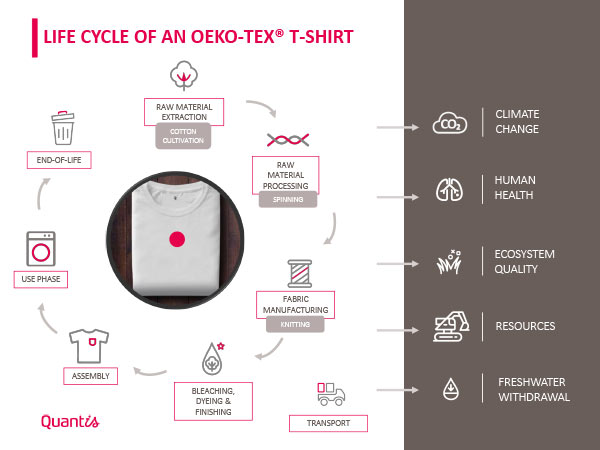
The main conclusions to be drawn from the LCA of this specific t-shirt are that there is not one single stage of the lifecycle of a product that is most harmful to the environment. Depending on the impact category, be it climate change or human health for instance, the impact of different stages may differ. Overall, however, it may be noted that for climate change, the use phase is usually the most impacting phase for textile products as the product lifetime plays a crucial role.
However, this depends heavily on consumer behaviour (how often the item is washed) since the main contributions to impacts are the energy and water required to wash and dry clothes. This highlights that all actors including customers, textile producers, brands and retailers play a part in making a product more environment-friendly.
The second and third main contributors to climate change are the raw material processing and bleaching, dyeing and finishing due to the energy required to power machines and equipment. For cotton cultivation, the climate change impacts come mainly from irrigation, fertiliser application and field work. The fabric manufacturing, transportation and disposal life cycle steps are all negligible, making up less than 5 per cent of the impact.
This project succeeded in testing the data already available thanks to the OEKO-TEX® certification and identifying several data gaps. The next step in the collaboration will be to devise a plan to fill those data gaps and improve data quality by making questions to the producers along the supply chain more specific to receive more relevant answers regarding production facilities. Ultimately, TESTEX aims to provide the carbon footprint of each facility and product calculated as a part of the OEKO-TEX® certification process. TESTEX looks forward to publishing the full results of the LCA project in the near future.

Our Location
TESTEX AG
Swiss Textile Testing Institute
Gotthardstrasse 61
8002 Zurich, Switzerland


